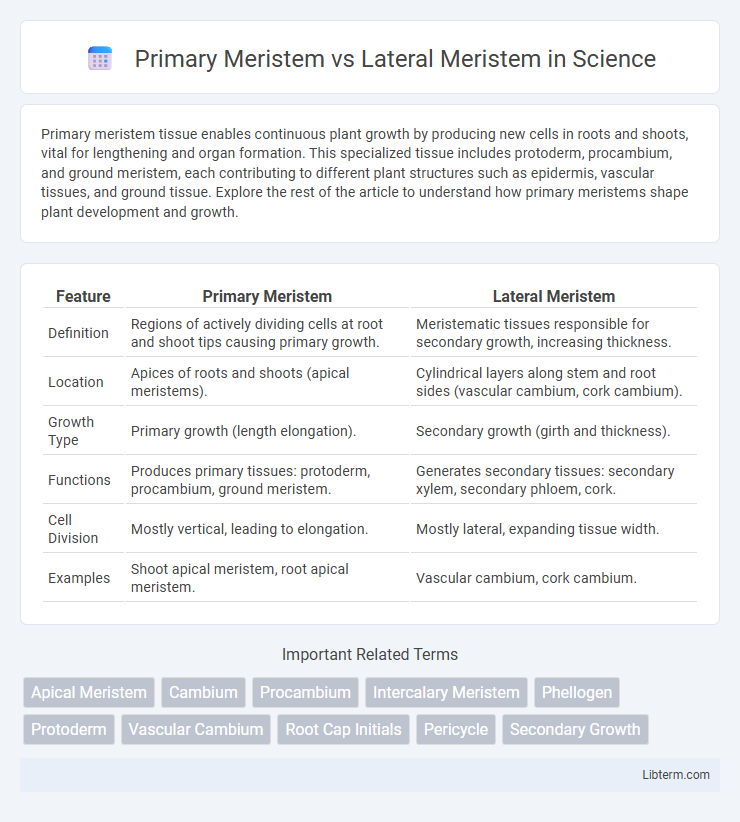Primary meristem tissue enables continuous plant growth by producing new cells in roots and shoots, vital for lengthening and organ formation. This specialized tissue includes protoderm, procambium, and ground meristem, each contributing to different plant structures such as epidermis, vascular tissues, and ground tissue. Explore the rest of the article to understand how primary meristems shape plant development and growth.
Table of Comparison
| Feature | Primary Meristem | Lateral Meristem |
|---|---|---|
| Definition | Regions of actively dividing cells at root and shoot tips causing primary growth. | Meristematic tissues responsible for secondary growth, increasing thickness. |
| Location | Apices of roots and shoots (apical meristems). | Cylindrical layers along stem and root sides (vascular cambium, cork cambium). |
| Growth Type | Primary growth (length elongation). | Secondary growth (girth and thickness). |
| Functions | Produces primary tissues: protoderm, procambium, ground meristem. | Generates secondary tissues: secondary xylem, secondary phloem, cork. |
| Cell Division | Mostly vertical, leading to elongation. | Mostly lateral, expanding tissue width. |
| Examples | Shoot apical meristem, root apical meristem. | Vascular cambium, cork cambium. |
Introduction to Plant Meristems
Plant meristems are specialized tissues responsible for continuous growth and development in plants. Primary meristems, including the apical meristems, drive vertical growth by producing new cells at the tips of roots and shoots. Lateral meristems, such as the vascular cambium and cork cambium, contribute to secondary growth by increasing the plant's girth through the formation of vascular and protective tissues.
Definition of Primary Meristem
Primary meristem refers to the regions of actively dividing cells located at the tips of roots and shoots responsible for the primary growth, which increases the length of the plant. These meristematic tissues differentiate into primary tissues such as protoderm, procambium, and ground meristem. Unlike lateral meristem, which contributes to secondary growth and thickness, primary meristem drives elongation and initial organ formation during early plant development.
Definition of Lateral Meristem
Lateral meristems are specialized regions of plant tissue responsible for secondary growth, enabling the increase in girth or thickness of stems and roots. Unlike primary meristems, which contribute to the elongation of plant parts, lateral meristems such as the vascular cambium and cork cambium produce new layers of vascular tissues and protective bark. These meristems play a critical role in woody plants by facilitating radial expansion and strengthening structural support.
Origin and Development of Meristems
Primary meristems originate from apical meristems located at the tips of roots and shoots, responsible for the primary growth and elongation of the plant. Lateral meristems develop from the procambium and ground meristem tissues during secondary growth, contributing to the thickening of stems and roots by producing secondary xylem and phloem. The differentiation and activity of these meristems are regulated by genetic and hormonal signals that guide the formation of various tissues essential for plant development.
Structure and Location of Primary Meristem
Primary meristems consist of apical meristems located at the tips of roots and shoots, characterized by small, densely packed, and actively dividing cells responsible for primary growth. They include three types: protoderm, procambium, and ground meristem, which differentiate into epidermis, vascular tissues, and ground tissues respectively. These meristems lie at the apex of shoots and roots, enabling elongation and the formation of primary tissues.
Structure and Location of Lateral Meristem
Lateral meristems are cylindrical layers of actively dividing cells located along the sides of stems and roots, primarily responsible for secondary growth and increasing girth. Unlike primary meristems, which are found at root and shoot tips, lateral meristems include the vascular cambium and cork cambium, producing secondary xylem, phloem, and protective bark tissues. Their structure as continuous rings enables the expansion of woody plants, supporting structural strength and nutrient transport.
Functions of Primary Meristem
Primary meristem is responsible for the elongation and primary growth of plants, producing cells that develop into the primary tissues such as epidermis, cortex, and vascular bundles. It facilitates vertical growth by generating new cells at the tips of roots and shoots, enabling plants to increase in height and length. In contrast, lateral meristem contributes to secondary growth, increasing the girth of stems and roots.
Functions of Lateral Meristem
Lateral meristem is responsible for secondary growth in plants, producing vascular cambium and cork cambium to increase stem and root thickness. It generates new layers of vascular tissue, facilitating efficient transport of water and nutrients while providing structural support. Unlike the primary meristem, which promotes lengthwise growth, the lateral meristem enables the plant to expand in girth and adapt to environmental stresses.
Key Differences: Primary vs Lateral Meristem
Primary meristem is responsible for the vertical growth of plants, producing primary tissues such as protoderm, procambium, and ground meristem that contribute to elongation. Lateral meristem, including vascular cambium and cork cambium, drives the secondary growth, increasing the plant's girth by forming secondary xylem and phloem. Key differences lie in their location; primary meristems are found at root and shoot tips, while lateral meristems are located along the stem and roots, facilitating thickness rather than height.
Significance in Plant Growth and Development
Primary meristem drives vertical growth by producing primary tissues such as the epidermis, cortex, and vascular bundles, essential for elongation and organ formation. Lateral meristem, including vascular cambium and cork cambium, enables secondary growth by increasing stem and root thickness, enhancing structural support and nutrient transport efficiency. Both meristems coordinate to optimize overall plant development, balancing height expansion with girth reinforcement.
Primary Meristem Infographic

 libterm.com
libterm.com